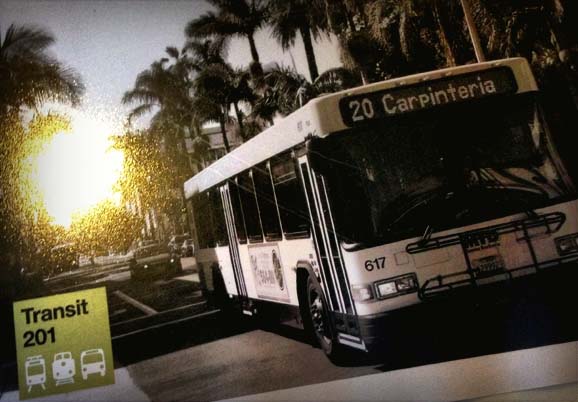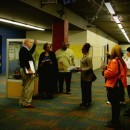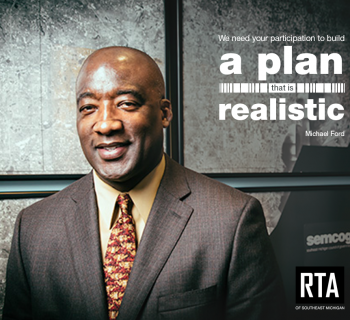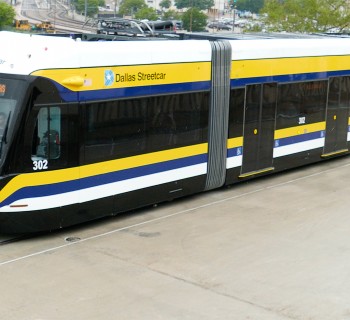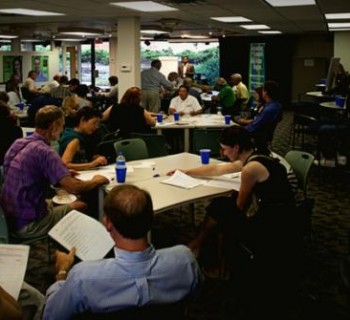Over the course of three Thursday evenings this fall, a group of about 15 self-proclaimed transit geeks--myself included--reported to class at Omnicorps Detroit in Eastern Market to explore exactly what we had yet to understand about transit.
Given the growing interest in Southeast Michigan for transit solutions including bus rapid transit, streetcars, and bus systems more generally, it seemed an opportune moment to educate myself.
Instructors Neil Greenberg and Hannah Kelley developed a curriculum to help anyone interested in transportation advocacy or policy understand transit operations and implementation.
With Greenberg's track-record as a transit mapping and scheduling consultant, creator of airBus at the University of Michigan, and founder of Freshwater Transit, and Kelley's experience as a planner in Ferndale’s Community and Economic Development Department, their knowledge of transportation systems and their complexity is comprehensive to say the least.
Ground Rules
- No Detroit allowed. To stay on task and on topic, we established a “Beachball” rule, meaning anytime someone went off on a tangent or made a reference to metro Detroit and/or its transit systems, anyone could shout, “Beachball!” to steer us back on course.
- Customers, people. Greenberg made it abundantly clear that we would not be discussing the “passenger” experience or how “passengers” use different modes of tranit. Instead, we would call these people customers, as they are, in fact, paying for and using a service, and should be treated as a customer.
Case Studies
In our provided course binder, we had printed materials taking us to places like Philidelphia, Los Angeles, Portland, Denver, Washington DC, Ottowa, Houston, and more.
We learned the differnce between a streetcar, commuter rail, light rail, heavy rail, and a bus, and what characteristics of a route determine which mode makes the most sense.
For example, if Joe Shmoe is traveling about 20 miles from Concord, Massachussettes—a historic residential town with a high average household income—to North Station in Central Boston, he’ll hop on the commuter rail because 1) it’s fast, 2) it’s convenient in that he won’t have to bother with parking, and 3) let’s be honest, he probably isn’t interested in riding a bus.
Transit Networks vs. Systems
We learned about cities that have one transit system, as opposed to one transit network. In case you're wondering what that means...
It means that in Denver, the Regional Transportation District is responsible for bus and light rail routes that pass through multiple municipalities, whereas in Washington D.C., there are multiple transit operators in the region responsible for their own municipalities, but the network appears seamless to the user (ahem, SMART and DDOT...Beachball!).
Different Routes Serve Different Purposes
A common misperception—especiallly about buses—is that there are redundancies in service. For example, you see two buses traveling the same route everyday—neither or only one of them at capacity—and think, “Inefficiency! I knew it!”
However, routes often parallel eachother but serve vastly different purposes. One may be an express route with fewer stops, or at a certain point along their routes they go opposite directions to serve people on opposite sides of town.
Behind the Scenes
The takeaway from our final day of class was perhaps the most eye-opening. We began by imagining an average Wednesday service on the Westheimer bus route in Houston: A customer stands at a stop, gets on the bus, pays a fare as the driver greets them, then takes a seat, and gets off the bus at their destination.
That’s it, right?
Wrong. We soon identified every little variable in that transit equation that is not-so-visible to the naked eye:
Automatic Pass Counters to gather data on who is riding; Road Supervisors to communicate with bus drivers about delays and road conditions; random drug testing of drivers mid-route; Automatic Vehicle Locators to help dispatch communicate between drivers; and managing urgent and non-urgent vehicle maintenance during and after a route.
We even looked at a list of the employees within the Metropolitan Transit Authority of Harris County in Houston: 3,511 employees and 635 active classifications. Whoa.
Not All BRT is Created Equally
In our second class, we took a deeper dive into the world of Bus Rapid Transit (BRT) to see exactly how all-encompassing the term has become. Some BRT is more “trunky” than others (meaning it’s the spine of a transit network); some BRT is more local and slow; some BRT serves as a feeder to connect to another transit route; and some serves as a precursor to heavier transit options in emerging areas that don’t yet have a need for light rail.
Bittersweet Endings
We ended the course by receiving certificates of completion (which will eventually be framed and hung on my office wall) and ditching the “Beachball” rule to discuss how we could actually take what we had learned and apply it in our own city and region. I’d like to say this part was all rainbows and butterflies, but it wasn’t. It was hard, uncomfortable, and slightly depressing.
We’ve got a ways to go, Metro Detroit, but if we all take the time to smell the roses (or transit) in other cities, eventually we might decide it’s worth investing in a 21st century transit system of our own.
The Takeaway
The 16 year old me would say the Jet’s pizza and pop we had at the start of each class was the best part of this entire course, but the real me would say it was rounding out my knowledge of transit systems and meeting a network of people that are just as interested in understanding what goes into creating really good, attractive, and functional transit.


